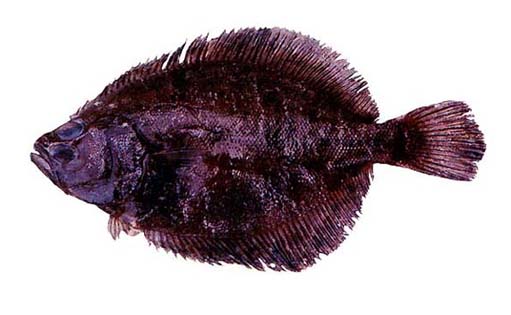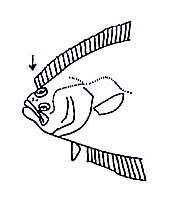ダルマガレイ科
- HOME
- デジタル図鑑
- パタゴニア海域の重要水族
- 硬骨魚綱 カレイ目
- ダルマガレイ科
ダルマガレイ科(Bothidae)

120 フンボルトヒラメ(Hunboruto-hirame)
Paralichthys adspersus(Steindachner, 1867)
特 徴:
背鰭72〜77軟条,臀鰭57〜65軟条,胸鰭11〜13軟条,腹鰭1棘,5軟条,鰓耙数9〜10+18〜22=27〜33。頭長は体長の28.6〜32.2%,眼径は2.6〜3.0%,肉質眼窩径は3.6〜4.7%,体高は45.1〜49.4%,吻長は5.7〜6.2%,両眼間隔は2.2〜3.3%,上顎長は12.4〜14.4%,尾柄高は10.0〜11.9%,胸鰭長は11.9〜13.2%,腹鰭長は5.9〜6.6%,背鰭高は11.6〜13.5%,臀鰭高は10.9〜13.3%。体は卵円形で著しく縦扁し,体長は体高の2.0〜2.3倍。頭は大きく,体長は頭長の約3.5倍。吻は短く,吻長は眼径よりやや大。眼は小さく,体長は上眼径の7〜9倍,上眼は下眼よりやや前方に位置する。頭部の上縁はほぼ直線状。口は大きく,斜位。上顎後端は上眼の後縁下に達する。両顎はほぼ同長,両顎に犬歯が1列に並び,前半部の歯は後半部の歯より大きくて強い。鰓耙は短い。擬鰓がある。有眼側の一対の鼻孔は相接近し小さく,前鼻孔は丸く後縁に1皮弁を有し,後鼻孔は卵円形で皮弁を有しない。無眼側の一対の鼻孔も相接近し小さく,背縁外郭に近く位置し,前鼻孔は丸く後縁に1皮弁を有し,後鼻孔は丸く皮弁を有しない。両眼間隔域は平坦で狭く,その幅は眼径よりやや小さい。背鰭起部は上眼の中央上かそれよりわずかに前方(上眼の前縁附近)に位置する。胸鰭は短く,有眼側では頭長の半分で,無眼側では頭長の約1/3。有眼側の鱗は櫛鱗で,無眼側の鱗は円鱗。側線は単線で,前半部に分枝と湾曲部を有し,後半部はほぼ直線状。
分 布:
ペルー,チリ沿岸.
備 考:
本種はしばしばメキシコに分布するParalichthys woolmaniと混同されて来たが,本種は有眼側に櫛鱗を有することと,より多い鰓耙数でそれとは容易に区別できる(Norman, 1934).
(中村 泉)
Material examined:
10 from Chile (246.0-363.5 mm SL), FAKU CP 39, 185-188, 370, 622-624, 630
Description:
D 72-77; A 57-65; P111-13; P2 Ⅰ, 5; GR 9-10+18-22=27-33; BR 7; LLS 90-112. HL 28.6-32.2% of SL; ED 2.6-3.0; FO 3.6-4.7; BD 45.1-49.4; SN 5.7-6.2; IO 2.2-3.3; UJ 12.4-14.4; CP 10.0-11.9; P1L 11.9-13.2; P2L 5.9-6.6; DH 11.6-13.5; AH 10.9-13.3.
Body elliptical, body depth 2.0-2.3 times in SL. Head large, about 3.5 times in SL. Snout slightly larger than eye diameter. Eye small, 7-9 times in head, upper eye slightly anterior to lower eye. Upper profile of head nearly straight. Mouth oblique, large, posterior margin of upper jaw reaching posterior margin of upper eye. Lower jaw not projected. Small uniserial caniniform teeth present, anterior teeth larger and stronger than posterior teeth on both jaws. Gill-rakers short. Pseudobranchiae present. Nostrils on ocular side small and closely situated each other, anterior nostril round without a flap. Nostrils on blind side closely situated each other near to dorsal profile of head; anterior nostril round with a flap posteriorly and posterior nostril round without a flap. Interorbital region flat and narrow, its width slightly shorter than eye diameter. Dorsal fin originating above middle of upper eye or slightly more forward (above anterior margin of upper eye). Pectoral fins short, about half of head on ocular side and about one-third of head on blind side. Pelvic fins on both sides subequal. Caudal fin double truncate. Scales ctenoid on ocular side and cycloid on blind side. Lateral line with a branch and curving anteriorly and fairly straight posteriorly.
Distribution:
Coasts of Peru and Chile.
Remarks:
This species appears to have been confused by many authors with the common Paralichthys of Mazatlan, Mexico (P. woolmani), from which it may be readily distinguished by the ctenoid scales on the ocular side and the larger number of gill-rakers (Norman, 1934).
(Izumi NAKAMURA)

Distribution of Paralichthys adspersus in Patagonia.

Head. Dorsal fin origin arrowed.